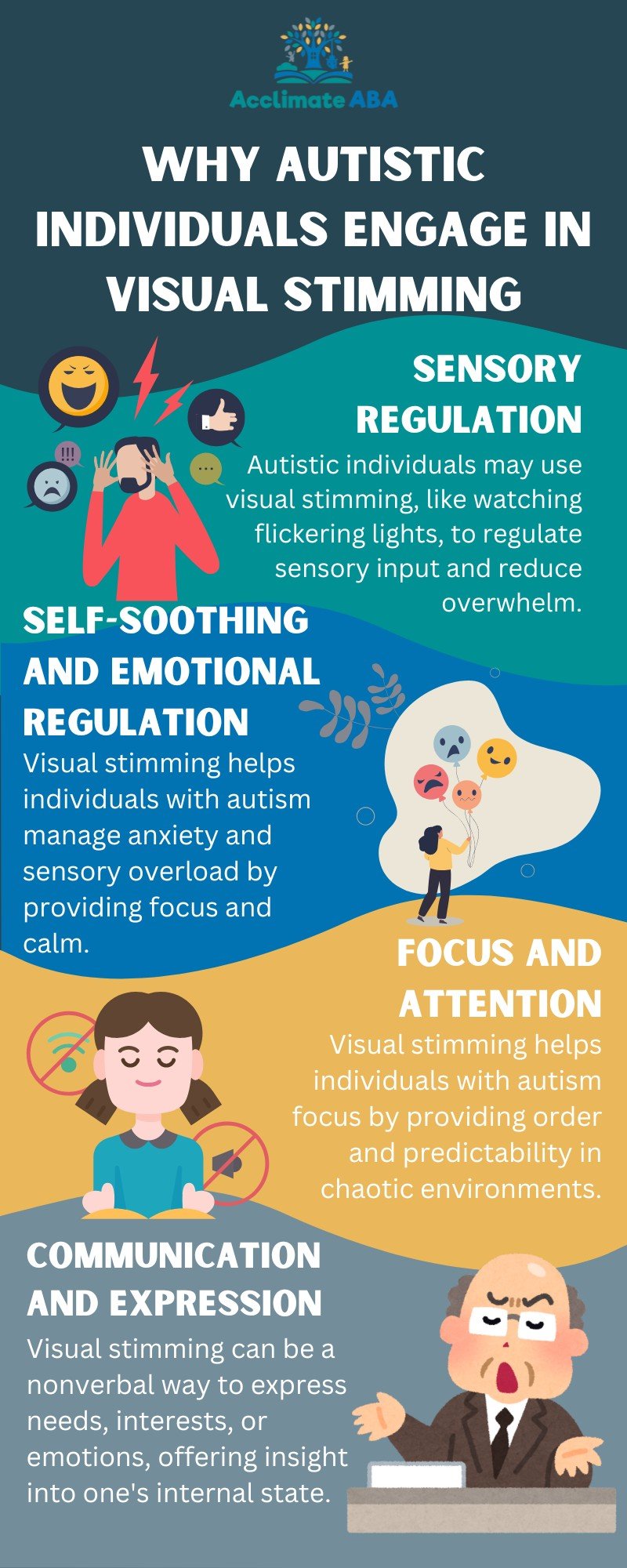Visual Stimming in Autism: Causes, Symptoms & Treatments
 Key Points:
Key Points:
- Visual stimming in autism refers to repetitive behaviors involving visual stimuli, such as watching flashing lights or hand-flapping.
- The causes of visual stimming are linked to sensory processing differences, emotional regulation, and self-soothing.
- There are various strategies to manage visual stimming, from sensory integration therapy to behavioral interventions like ABA therapy.
Autism Spectrum Disorder (ASD) affects how individuals process sensory information, leading to various behaviors that might seem unusual to others. One of the more common behaviors seen in individuals with autism is visual stimming, which involves repetitive visual activities like watching moving lights, flicking fingers, or staring at certain objects. This behavior can sometimes be a response to sensory overload, helping individuals self-regulate and manage overwhelming stimuli.
According to studies, approximately 44% of individuals with autism are reported to exhibit some form of stimming action, including visual stimming. These behaviors are often misunderstood, but understanding their root causes can help parents and caregivers provide better support and strategies for managing them.
In this article, we will explore the causes of visual stimming in autism, the symptoms to look out for, and the treatment options that can help individuals cope with these behaviors in a more regulated way. By gaining a deeper understanding, families can better support their loved ones and help improve daily functioning.
What is Visual Stimming in Autism?
Visual stimming in autism refers to repetitive behaviors that involve visual stimuli. It is one of the more common forms of stimming, alongside other sensory stimming activities such as tactile or auditory stimming. Visual stimming behaviors can be triggered by specific objects, movements, or even patterns. Some common examples include:
- Staring at lights, spinning objects, or patterns
- Flicking fingers in front of the eyes
- Watching shadows, reflections, or repetitive movements
- Watching objects spin or move in a circular pattern
While these behaviors may seem strange to those who aren’t familiar with autism, for individuals on the spectrum, visual stimming can serve several functions, including self-regulation, focusing, or providing comfort. For some individuals, visual stimming is a way to escape from overwhelming sensory input or emotions.
 Can Autistic Adults Also Exhibit Stimming Behaviors?
Can Autistic Adults Also Exhibit Stimming Behaviors?
You might have heard the term “stimming” in reference to children with autism. But what about autistic adults? The truth is, stimming doesn’t disappear as children grow older; it often continues into adulthood, just in different forms. And that’s perfectly okay. For many autistic adults, stimming is a natural and helpful way to manage stress, maintain focus, or self-soothe.
For adults with autism, stimming can be a vital coping mechanism, helping them deal with overwhelming emotions or sensory overload. Whether it’s tapping a pen, rocking gently, or repeating certain words, these behaviors offer comfort and help maintain calm during stressful situations.
Interestingly, stimming can also aid in focus. Many autistic adults find that engaging in repetitive actions helps them concentrate better and block out distractions, which is especially useful in busy or chaotic environments.
What Are the Symptoms of Visual Stimming in Autism?
Visual stimming behaviors can present in a variety of ways, depending on the individual. Some of the most common signs of visual stimming autism include:
- Hand-flapping or finger-flicking in front of the eyes
- Staring at light sources such as light bulbs, lamps, or reflections
- Repetitive movements of objects, such as spinning a toy or watching an object roll back and forth
- Focus on patterns or repetitive visuals, like looking at a pattern on a wall or watching cars or wheels move in a repetitive manner.
- Watching objects or scenes from unusual angles, such as bending over to watch something from the floor or looking at objects through a specific lens or device
- Head tilting or body swaying while engaging in visual stimming behaviors
The intensity and frequency of these behaviors can vary widely. For some individuals, visual stimming may occur occasionally, while for others, it may be a frequent or constant activity. These behaviors may be more prevalent during moments of high stress, overstimulation, or when the individual is trying to self-soothe.
How to Manage Visual Stimming in Autism
While visual stimming is a natural part of autism, there are strategies that can help reduce its intensity or help autistic individuals engage in more functional activities. Below are several approaches that can be used to manage visual stimming:
1. Provide Structured Sensory Breaks
Sensory overload is a common trigger for visual stimming behaviors. Providing regular sensory breaks can help individuals avoid sensory overload, thereby reducing the need to engage in visual stimming. Structured sensory breaks can include activities such as:
- Deep pressure activities (e.g., using a weighted blanket)
- Movement breaks (e.g., jumping on a trampoline)
- Quiet time in a calming, dimly lit room
These activities help the individual regulate sensory input and avoid overstimulation, reducing the need to rely on visual stimming as a coping mechanism.
2. Offer Alternative Behaviors
Instead of discouraging visual stimming, parents and caregivers can introduce alternative behaviors that may fulfill the same need. This could include:
- Providing visually stimulating toys, such as light-up objects or kaleidoscopes, channels the need for visual stimulation into more appropriate outlets.
- Teaching the individual to use visual aids, like a picture schedule or visual timers, to help them focus and manage their sensory needs.
The goal is to provide an alternative to the behavior that is still satisfying but less disruptive to daily functioning.
3. Implement ABA Therapy
Applied Behavior Analysis (ABA) therapy is an effective tool for managing stimming behaviors, including visual stimming. ABA focuses on reinforcing positive behaviors and reducing those that interfere with daily functioning. With ABA, a therapist can work with the individual to develop specific strategies to manage visual stimming, such as:
- Teaching alternative, more socially acceptable ways to engage in stimming
- Reinforcing the individual to focus on other tasks or participate in activities that don’t involve stimming
- Using positive reinforcement when the individual engages in less intense stimming or focuses on a non-stimulating task
ABA therapy can help individuals with autism manage visual stimming by providing them with the tools to regulate their sensory needs in more functional ways.
4. Environmental Modifications
Creating a sensory-friendly environment can also help reduce the frequency of visual stimming. This may involve:
- Dimming bright lights or using soft lighting to reduce the intensity of visual stimuli
- Minimizing visual clutter or distractions in the home or classroom
- Offering objects or activities that engage the individual in a way that reduces the need for stimming, such as puzzles, art, or games
By adjusting the environment, you can help the individual feel more at ease and reduce the need to seek comfort through visual stimming.
ABA Therapy for Visual Stimming in Utah
If you are looking for expert support in managing visual stimming and other behaviors associated with autism, Acclimate ABA offers ABA therapy in Utah. Our ABA therapy services are designed to help individuals with autism improve their behavior, communication, and daily functioning. Through personalized interventions, we work with families to create a tailored approach that addresses specific challenges like visual stimming.
At Acclimate ABA, our team is dedicated to supporting individuals and their families in managing sensory issues and improving overall quality of life. Contact us today to learn how ABA therapy in Utah can help your loved one with autism thrive in their environment.
